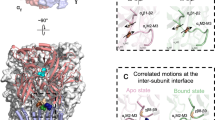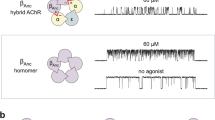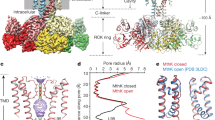Abstract
Acetylcholine-like drugs cause ion channels in the skeletal muscle endplate to open briefly1, producing, at random intervals, rectangular pulses of current with constant amplitude but random duration, that can be recorded by the patch clamp method2,3. However, even when the agonist concentration is so low that channel activations are very well separated, we have observed, with high resolution methods4, that openings may be interrupted by shut periods (gaps) so brief that they are very unlikely to arise from two independent channel activations. This sort of behaviour has been predicted on the basis that two or more openings might occur during the time for which the receptor remains occupied by agonist5,6. If this were correct, important new information about agonist activation of ion channels could be obtained from measurements of the gaps between openings. However, short gaps could arise in other ways: for example from brief blockage of the ion channel7, perhaps by the agonist itself. We now present results obtained with the acetylcholine-like agonist, suberyldicholine (SubCh, 20–100 nM), which suggest that the brief gaps do not result from ion channel block by the agonist itself, but which are consistent with a mechanism in which the channel opens and closes several times during a single agonist receptor occupancy. We have also observed that the number of short (<1 ms) current pulses is greater than we expected.
This is a preview of subscription content, access via your institution
Access options
Subscribe to this journal
Receive 51 print issues and online access
$199.00 per year
only $3.90 per issue
Buy this article
- Purchase on Springer Link
- Instant access to full article PDF
Prices may be subject to local taxes which are calculated during checkout
Similar content being viewed by others
References
Katz, B. & Miledi, R. J. Physiol., Lond. 230, 707–717 (1973).
Neher, E. & Sakmann, B. Nature 260, 799–802 (1976).
Sakmann, B., Patlak, J. & Neher, E. Nature 286, 71–73 (1980).
Hamill, O. P., Marty, A., Neher, E., Sakmann, B. & Sigworth, F. J. Pflügers Arch. ges. Physiol. 391, 85–100 (1981).
Colquhoun, D. & Hawkes, A. G. Proc. R. Soc. B199, 231–262 (1977).
Colquhoun, D. & Hawkes, A. G. Proc. R. Soc. B211, 205–235 (1981).
Neher, E. & Steinbach, J. H. J. Physiol., Lond. 277, 153–176 (1978).
Adams, P. R. & Sakmann, B. Proc. natn. Acad. Sci. U.S.A. 75, 2994–2998 (1978).
Colquhoun, D. in The Receptors (ed. O'Brien, R. D.) 93–142 (Plenum, New York, 1979).
Anderson, C. R. & Stevens, C. F. J. Physiol., Lond. 235, 655–691 (1973).
Author information
Authors and Affiliations
Rights and permissions
About this article
Cite this article
Colquhoun, D., Sakmann, B. Fluctuations in the microsecond time range of the current through single acetylcholine receptor ion channels. Nature 294, 464–466 (1981). https://doi.org/10.1038/294464a0
Received:
Accepted:
Issue Date:
DOI: https://doi.org/10.1038/294464a0
This article is cited by
-
Derepression may masquerade as activation in ligand-gated ion channels
Nature Communications (2023)
-
Detection and trapping of intermediate states priming nicotinic receptor channel opening
Nature (2009)
-
On the nature of partial agonism in the nicotinic receptor superfamily
Nature (2008)
-
Pulling single molecules of titin by AFM—recent advances and physiological implications
Pflügers Archiv - European Journal of Physiology (2008)
-
On the analysis of ligand-directed signaling at G protein-coupled receptors
Naunyn-Schmiedeberg's Archives of Pharmacology (2008)
Comments
By submitting a comment you agree to abide by our Terms and Community Guidelines. If you find something abusive or that does not comply with our terms or guidelines please flag it as inappropriate.



